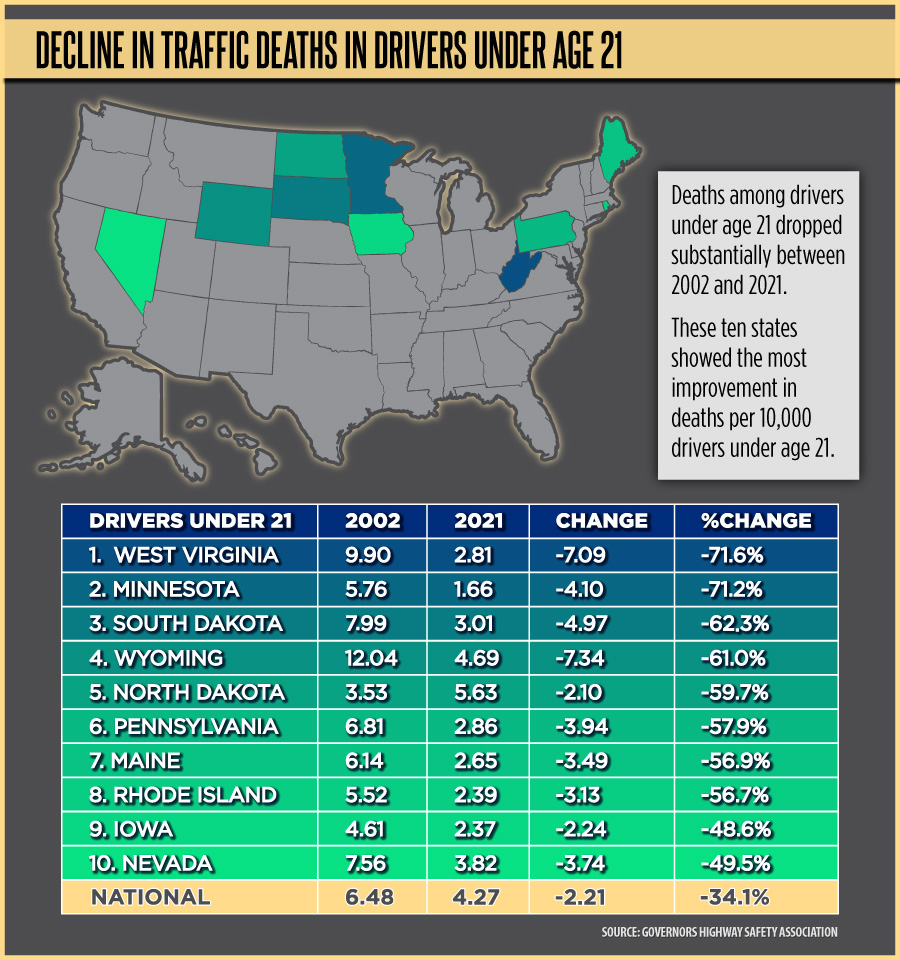An emphasis on better, more extensive training for young drivers appears to be working.
A study released last week by the Governors Highway Safety Association shows fatal crashes involving drivers under age 21 went down 38% between 2002 and 2021, and deaths of young drivers dropped 45%, compared to an 11% increase for drivers 21 and older. Because the rate of driving among young people has gone down, the association also looked at deaths per 10,000 licensed drivers and found deaths of young drivers dropped 34%, compared to a 12% decrease for drivers 21 and older.
Those positive changes can be attributed to five key factors, the most important of which is all states adopting a graduated license for teens under 18, said Pam Shadel Fischer, the study’s author and the association’s senior director of external engagement.
State requirements vary, but generally graduated license drivers under 18 must complete a minimum number of hours of supervised driving over a period of time such as three or six months before they can take a test for a limited license. That license can limit how many young people they can have in the vehicle, hours when they are allowed to drive and prohibit use of cellphones or other electronic devices.
Pennsylvania requires drivers under 18 to have 65 hours of supervised driving over six months before they can take a driving test, including 10 hours at night and five in adverse weather conditions. They can’t drive from 11 p.m. to 5 a.m. and can have only one person under age 18 in the vehicle for the first six months.
“It’s been so incredibly effective, and it’s painless,” Fischer said in an interview. “We’re successful and we’re doing well, but I know we can do even better. It looks like we have put the right things in place.”
Before every state adopted some version of the graduated license, some had very few requirements and almost no limitations for young drivers. A 16-year-old could get a learner’s permit, immediately take a test for a license and get it if they passed the test, regardless of their lack of training.
Fischer, considered a national expert in teen driving, said that was dangerous because the human brain hasn’t developed enough at that age to successfully recognize and navigate through dangerous situations. Setting a training time such as six months and requiring a minimum number of supervised hours driving better prepares a young person for driving without supervision.
Tim Rogers, president of Rogers Driving School in Ross, stressed that driving is a learned skill that takes practice, so he isn’t surprised that requiring more training has reduced deaths.
“I do think the GDL was a great innovation,” Rogers said. “It definitely provided training and practice. That is the key. It takes practice and experience.
“On average, it takes about five years to get to the skill level of an average driver — not a really good driver, an average driver.”
Fischer said states should increase the emphasis on five aspects of driver education: the graduated license; parent or adult involvement in training; driver education and training available for everyone; peer-to-peer programs among young drivers; and technology improvements such as lane-departure warning, blind spot monitoring and automatic emergency braking. She also recommends adding another point of emphasis: making sure young drivers know how to use the technological improvements so they can benefit from them as much as possible.
“When parents are really involved … it makes a big difference,” she said.
While there have been substantial improvements, Fischer said, more can be done. For example, Maryland and New Jersey require all new drivers to go through the graduated license process.
“There’s nothing magical about turning 18 that allows you to learn how to drive quicker,” she said. “Everyone should have to go through the graduated license.”
Despite additional training for young drivers, Fischer said it is not surprising that driving fatalities are going up with age. It’s normal that drivers get “a sense of overconfidence” and don’t always follow what they know, leading to deaths attributed to dangerous behaviors such as drunken or distracted driving, speeding and not wearing seat belts.
“I think people are cavalier as they become more experienced,” she said. “As people get more confidence, they start to do more risky things. We need the public to understand that’s unacceptable.”
Ed covers transportation at the Pittsburgh Post-Gazette, but he's currently on strike. Email him at eblazina@unionprogress.com.



